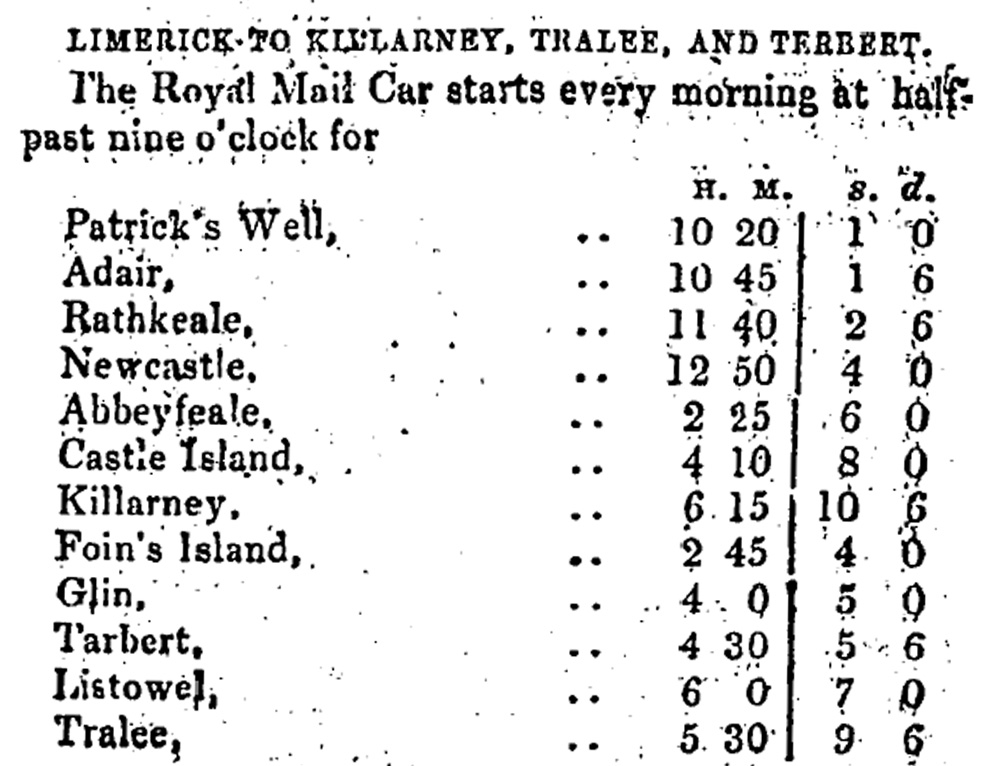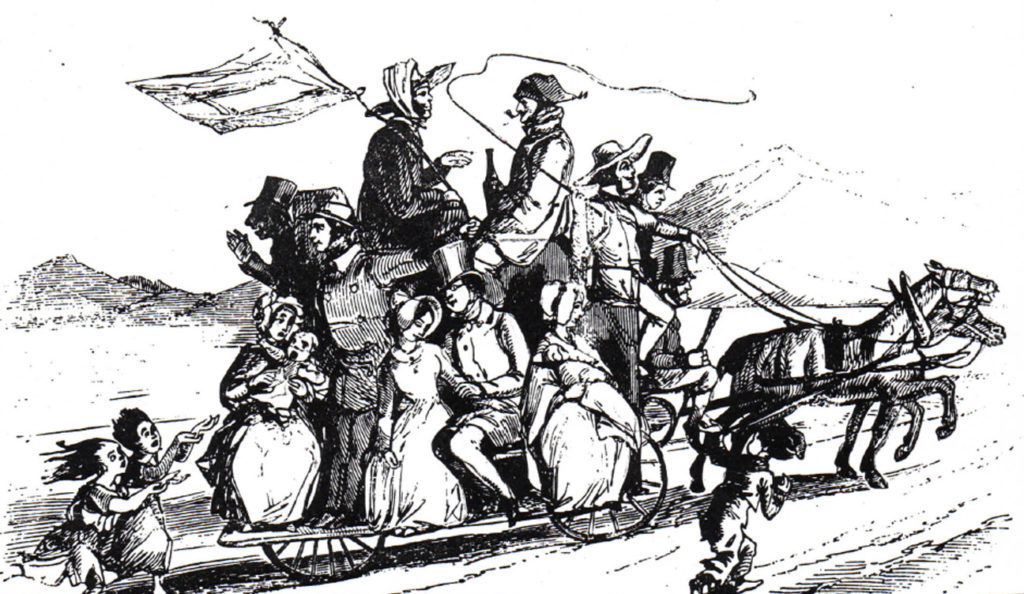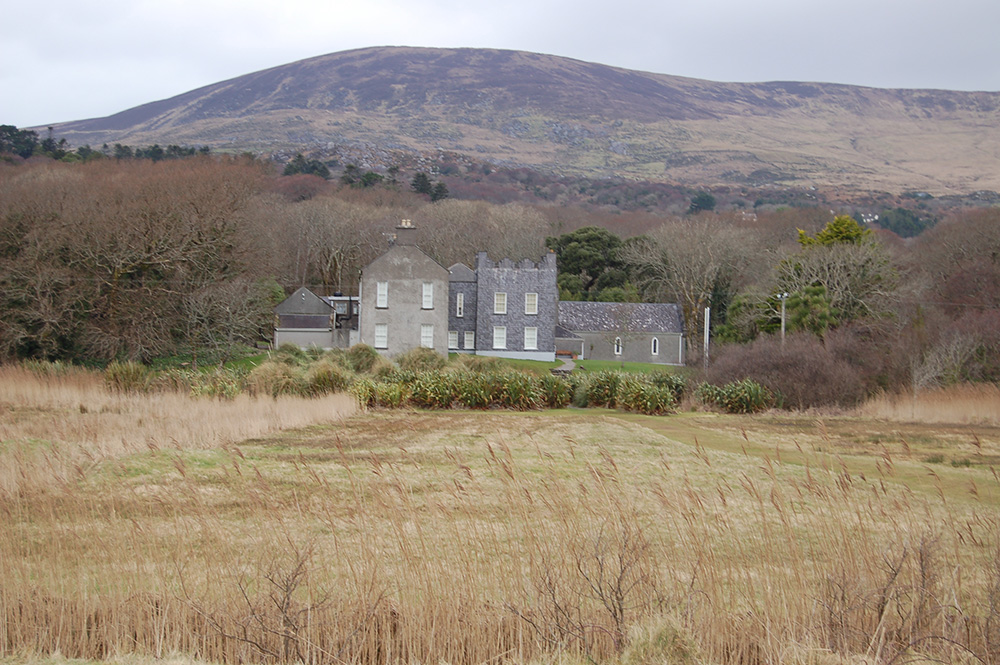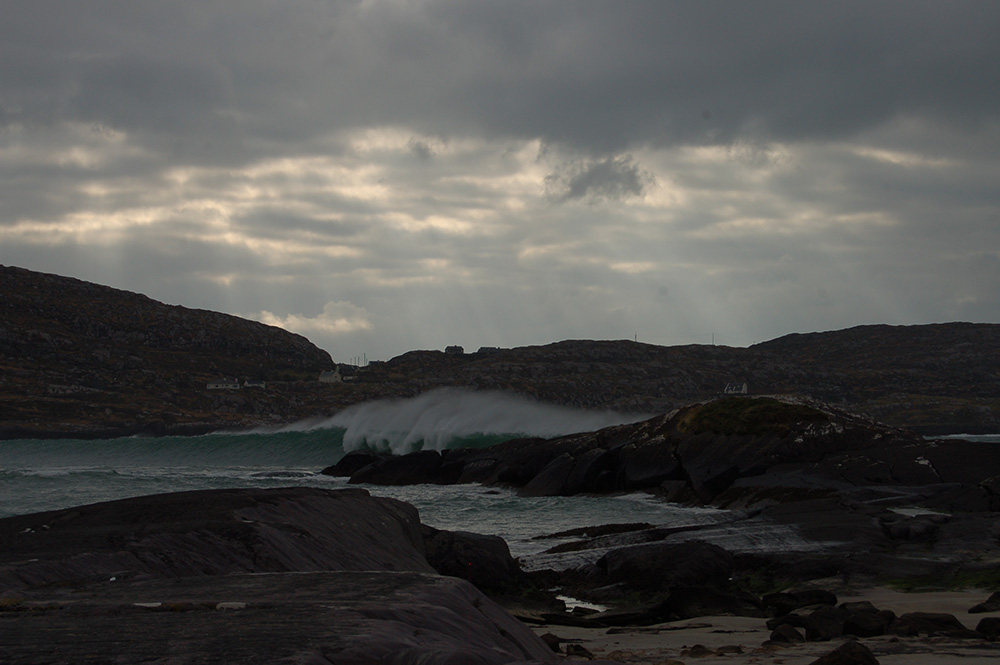'At school Bianconi was noted as a stupid dunce' - Obituary to Bianconi, 'the great pioneer of passenger traffic in Ireland'1
Michael O’Donohoe’s attention was drawn by Italian born Charles Bianconi’s lease of land at Main Street, Castleisland.
Bianconi (1786-1875), founder of a public transport system in Ireland in the early nineteenth century, resided at Longfield Park in Co Tipperary. Bianconi had more than 1,000 horses in his stables and his cars ran daily over 4,244 miles of road.

Bianconi leased land elsewhere in Kerry including Glenbeigh and Ballylongford. In Castle Street, Tralee he kept a corn stores, warehouse, stables and a counting house.2

In the mid nineteenth century, John Mitchel’s arrival in the Maine Valley was in a Bianconi car:
Coming down Caol-na-Sprida in a Bianconi car about the middle of the 19th century, John Mitchel, the great Young Ireland patriot, exclaimed, when the splendid valley opened to his view, and Castlemaine Bay shining in the distance – “It is a valley worth fighting for.” And the originator and founder of the Land League, that earnest, true-souled patriot, Michael Davitt, many decades later, at the same place, gave expression to the same words.3
And buttermen of the district utilised Bianconi’s cars:
Before the advent of the railway train from Gortatlea, in the early seventies, the butter was despatched by car to Tralee, and to Cork via Farranfore. Earlier than that it was carried by car and “sleds” all the way to Cork by road. The “sleds” and sometimes the horse, were sold in the city and the carriers came back home in a Bianconi car.4

Bianconi has left behind him a name unsullied by a word of detraction
Bianconi’s early history
Bianconi’s early history in Ireland was sketched in 1837:
Some twenty years since an Italian boy came into the south of Ireland to sell some prints of which he had a small and very indifferent collection. He contrived to maintain himself and seeing that there was a great want of coach conveyance in the county of Tipperary where he resided, he made the speculation of buying an old horse and an Irish outside jaunting-car which had been cast aside as unfit for further use.
The car could accommodate six passengers with a driver in front and ‘sure the baggage could be got in the well’. Bianconi, ‘pronounced in Munster By-and-coney’, was described as a civil man who commenced running the car between Clonmel and Cahir where there had previously been no public transport and by degrees his establishment increased, ‘the cars now travel through one half of Ireland’.5
Charles Bianconi married Eliza, daughter of Patrick Hayes in February 1827. Two of their children married into the family of the Liberator.6

Bianconi’s eldest daughter, Catherine Henrietta, who died abroad in her youth, was highly regarded in Co Tipperary for her benevolence. On her death in 1854, it was reported that ‘the poor people were overwhelmed with grief, all work was suspended even the workmen testified by their unchecked sorrow how their felt her loss’.
Her body was returned to Ireland seven years later:
Thousands congregated – at the railway station there could not have been less than three hundred people who assembled with becoming reverence and stood with uncovered heads and prayerful lips as the procession swept its slow length along.7
_______________
1 Morning Post, 24 September 1875. 'Many of the gentry in the south of Ireland yet point with some pride to prints hanging on the walls, coloured landscapes &c, and tell their guests that these were purchased by their fathers from Charles Bianconi'. 2 In 1844, coach builders Daniel O'Sullivan and Sons were described as 'the Bianconi of Kerry'. An advertisement in the Tralee Chronicle and Killarney Echo of 21 February 1852 revealed that the company, then based also in Castle-street Tralee, had been established for more than 20 years and boasted of 'well appointed cars of every kind and steady and sober drivers'. 3 T M Donovan's History, p71. 4 ibid, pp180-181. 5 Kerry Evening Post, 4 March 1837. 6 Charles Thomas Bianconi, born in 1831, was appointed chamberlain to Pope Pius IX in 1855, and married Eileen O'Connell (1838-1919), second daughter of Christopher Fitzsimon Esq of Glancullen, Co Dublin and granddaughter of Daniel O'Connell, on 27 April 1859. Their daughter Ellen Mary Joseph O'Connell Bianconi was born the following year, and married journalist, Victor Collins of Notting-hill on 19 August 1880 (couple had ten children). Their second daughter Lily married Clement Ryan of Scarteen, Co Limerick on 30 May 1882. Charles Bianconi jnr died at Holyhead on 2 March 1864 on his way to London; Charlotte, one of his twin infant daughters died one week later, 10 March 1864. Mary Anne Bianconi, born in 1840, wife of Morgan John O'Connell, MP (1811-1875) and author of the two-volume The Last Colonel of the Irish Brigade (1892) dedicated to the memory of her husband. Mary Anne, who died in January 1908, published a biography of her father in 1878. A 52-pg manuscript, Reminiscences by Mary Anne O'Connell concerning her father Charles Bianconi and her husband John Morgan O'Connell is held at the National Library of Ireland. Her son John Coppinger O'Connell (later Bianconi) was born in 1871. A daughter Elizabeth died in infancy. 7 Catherine Henrietta, born in Dublin-street in 1828, died after a long illness at Pisa, unmarried, in 1854. Her remains were returned to Ireland in October 1861 for interment in a mortuary chapel at Boherlahan, Co Tipperary designed by Giovanni Maria Benzoni. The monument was inscribed: Erected by Charles Bianconi to the memory of his beloved daughter Kate Henrietta, whose remains repose beneath. She was born at Clonmel, 4th June, 1828 and died at Pisa 27 May 1854. May she rest in eternal peace. Amen.



